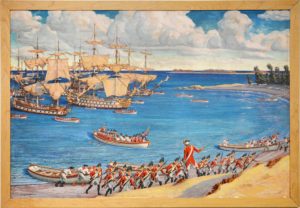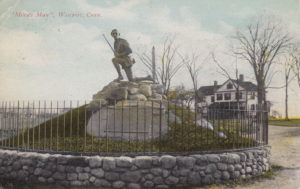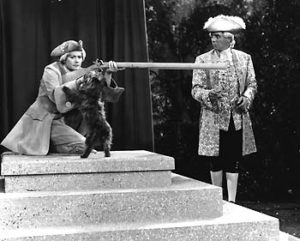By Kathleen Motes Bennewitz
On the morning of June 17, 1910, during the observance of “Bunker Hill Day,” all roads, trains, and trolleys appeared headed to Compo Beach. Over a thousand Connecticut residents descended upon Westport for a patriotic, event-filled unveiling of The Minute Man monument. Temporarily concealed by canvas and a bunting-clad dais was a life-sized bronze of a farmer-turned-soldier—with his powder horn and musket at the ready—kneeling atop a grassy pedestal that rose some six feet above the roadway. The monument was erected to honor the heroism of patriots who defended the country when the British invaded Connecticut at Compo Beach on April 25, 1777, and in the ensuing two days of conflict at Danbury and Ridgefield.
H. Daniel Webster Commemorates the Minuteman

Robert Penn Lambdin (1886-1981), The British Landing at Cedar Point, April 25, 1777 (1955), oil on Masonite. Westport Public Art Collections.
Created by Westport artist H. Daniel Webster (1880-1912), The Minute Man is sited in the center of the intersection at Compo Road South and Compo Beach Road, said to be the exact spot of the fiercest engagement between British and Continental militias that April evening. After accepting the statue and turning it over to the town’s care, Lewis B. Curtis, president of the Connecticut Sons of the American Revolution, declared that “Westport should always cherish among their brightest possessions, this spot and the monument, which we have erected to commemorate the noble deeds enacted here.”
Webster’s minuteman is one of four known monuments honoring civilian patriots who took up arms in a minute’s notice to defend the American colonies. The most famous is Daniel Chester French’s minuteman statue, erected for the centennial of the April 19, 1775, Battle at the North Bridge at Concord, where, as Ralph Waldo Emerson wrote, “the shot heard round the world.” The other two bronzes, sculpted by the husband-wife team of Henry Hudson Kitson and Theo Alice Ruggles Kitson, are at Lexington (1899) and Framingham, Massachusetts (1905).

Minute Man postcard, Westport (1912). Unknown Artist, Wikimedia Commons. Used through Public Domain.
Westport’s celebration marked the climax of an eight-year campaign for a monument that began in 1902 when the town secured title to Compo Beach as a public resort. Making the project a reality needed the zealous effort of William H. Burr Jr., a successful farmer, influential citizen, and avid student of the American Revolution. However, his success was dependent upon strident patronage of the Connecticut Sons of the American Revolution (CSAR) and a $2,000 appropriation in 1907 by the Connecticut General Assembly. To sponsor this monument and The Defenders’ Monument (1910) at New Haven, lawmakers expanded the role of the State Commission on Sculpture. This act made Connecticut the first state in the nation to have an official body approving the design, materials, and location of publicly funded art on municipal land beyond the capitol building and grounds.
H. Daniel Webster was a rising 29-year-old artist when he received the commission in 1909. Three years earlier, he had moved from New York City to Westport to join its nascent artist community. After modeling the figure at his Westport studio, he had it cast by Tiffany & Co. at Roman Bronze Works, the country’s preeminent art foundry. To complete the monument, he asked nearby residents to donate fieldstone for the foundation wall and large, asymmetrical boulders for the earthen mound and to house the bronze plaques. The finished cost was $2,900, of which the state contributed $800 and the CSAR $2,100 through donations.
Capturing “The Spirit of ’76”
Webster was among the sculptors of the late 19th and early 20th centuries who benefited from the nation’s desire for sculptural projects honoring historical figures and heroes of other conflicts after the Civil War. To provide scope, The American Art Annual for 1907-08 included four-pages of commemorative projects under the headline “Important Monumental Sculpture Erected Since October 1905.” For the National SAR, such monuments and a “plaque” program (which the Connecticut SAR launched in 1892) helped to “perpetuate the spirit of ’76” by enabling future generations to “know the history of that spot.”
In addition, The Minute Man’s location at an intersection of roads leading to Long Island Sound made it perfect for historical tourism in the age of the automobile. From June 27 to 30, 1914, the SAR held a “Washington Journey Trip” along George Washington’s route from Philadelphia to Cambridge to assume command of the Continental army on July 3, 1775. The motor trip included Westport stops to The Minute Man and Compo Beach.
Upon unveiling, The Minute Man became the most iconic symbol of Westport and its origins. It was the emblem for the 1935 town centennial and a 1986 new town flag. On May 6, 1957, the beloved statue even made its national television debut on I Love Lucy. Today, it is a Westport historic landmark and has been restored to its full glory.
Kathleen Motes Bennewitz serves as Westport’s town curator and helps manage the Westport Public Art Collections. She has worked for art and historical museums across the country and today is an independent American art historian and exhibition curator.










